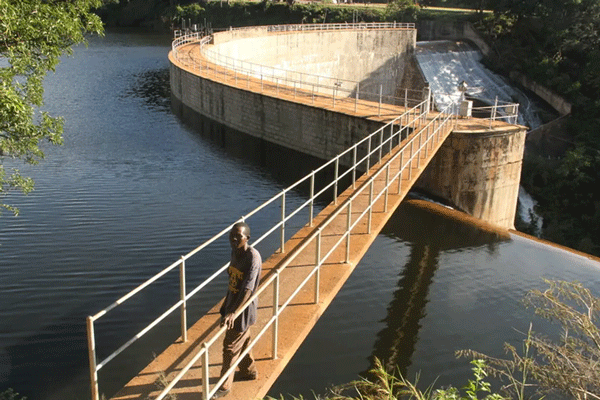
BY TONDERAYI MATONHO THE Mashonaland Central lifeline, the Mazowe River — with its water heavily fouled by artisanal mining and chemicals from gold processing activities alongside its banks, is slowly succumbing to the effects of pollution and degradation, confirming a crisis long highlighted by ecological experts more than two decades ago, it has emerged.
Environs of Mazowe River and its tributaries have been barrowed by thousands of gold panners, who like a plague of rats, have overrun the area to a point that the river and its streams are hardly recognisable.
Mazowe River rises about 40 kilometres north of Harare, the capital, flowing north and then north-east where it picks up Nyadire River close to the Mozambican border, before joining Rwenya River, a tributary of the mighty Zambezi River.
The 400-km river, whose enchanting forests and woodlands are being decimated by the marauding gold diggers, has a catchment basin of about 39 000 square kilometres, according to Wikipedia.
Recent studies have revealed that hundreds of tonnes of chemicals and waste-water from unbridled mining activities along the river’s banks are being dumped annually into Mazowe River, accounting for a 5% of the river’s volume. “This has pushed into extinction almost a third of the river’s native fish species over the years and made long stretches unfit even for irrigation,” notes the University of Zimbabwe’s Institute of Environmental Studies in one of its recent working and discussion papers.
Like thousands of other Masholand Central dwellers, Langford Chirere (68), bemoans the slow death of many parts of a once great flowing river and its tributaries in Mashonaland Central’s heartland.
Chirere, who has eight children and 24 grandchildren, used to work at Jumbo Mine, placed under judicial management by government in 2016.
He is now an artisanal miner, a very popular, dangerous and destructive mining venture in the region which has brought huge costs to the environment and its ecosystems. “I have no choice, but to adjust. What else can I do?” asks Chirere rhetorically, in a recent interview at his base, marked by an unsightly site of uncovered deep gullies and pits.
- Chamisa under fire over US$120K donation
- Mavhunga puts DeMbare into Chibuku quarterfinals
- Pension funds bet on Cabora Bassa oilfields
- Councils defy govt fire tender directive
Keep Reading
From a distance while standing at his base, Chirere used to observe the silvery flow of Mazowe River, but not anymore. His viewpoint of the water and the land has now been lost forever because of the heavily degraded parts of the river system.
About 10km from Chirere’s base is the Mazowe Dam. Built across the Mazowe River in 1918 for irrigating citrus plantations and annual crops like maize, soyabeans and wheat, it is a concrete arch dam. It used to offer a number of recreational activities as well.
Yet again, not anymore.
And the reasons why abounds. Corruption, lawlessness and complete disregard of the delicate nature of the environment are just a few of many reasons. “What are you doing?” a security guard at the Mazowe damwall demands.
“Nothing,” replies a stocky young man, lurking outside the main gate at the lower-end of the eastern side of the Mazowe Dam.
A heavy truck then suddenly appears. After a brief conversation, money quickly and silently exchanges hands between the stocky young man and the security guard.
This correspondent came across this encounter after a tip-off from locals that trucks came often to dump untreated chemical waste into a tributary of the Mazowe River.
This was just one highlight why Mazowe River and the dam on it were no longer the gems they used to be.
According to the Zimbabwe National Water Authority (Zinwa) a number of large mines in the Mazowe catchment “are a threat to water quality due to the waste-water and chemicals they release into the surface water bodies”.
Confiding to this correspondent on condition of anonymity for fear of victimisation, a senior Zinwa official based at the Mazowe district office said: “The mine slime dumps from the resultant processing activities at the big mines affect groundwater since most of these dumps are not lined and some of the dumps are also not properly vegetated hence siltation and dumping of waste in nearby streams and tributaries cannot be ruled out.”
In 2018, mine waste spillages turned part of the Mazowe River red. Another spillage turned it milky white. The one by the stocky young man at the lower-eastern end of the Mazowe Dam, tainted the tributary into a toxic shade of maroon.
The ubiquity of pollution-related diseases haunts residents and villagers in Mazowe district and beyond, who live in constant fear of an outbreak and possible unexplained mortalities. To help fight pollution in the Mazowe River catchment area, young environmentalist, Archieford Chemhere of Action 24 suggested: “With advanced technologies now easily available, GPS data can easily be emailed and uploaded onto a Web-based ‘pollution map’ for the whole world to see.”
For all its former pride as one of the major internal rivers in Zimbabwe that include Angwa, Runde, Rwenya, Sanyati, Save and Shangani, Mazowe River is now known for massive pollution and degradation.
Tragically, the Zimbabwean government, blinded by the desire to avail job opportunities to thousands of its young population through whatever means which include gold panning, is yet to come to terms with the disaster in its midst simply because environmental degradation is not yet a concern.
The World Bank, however, calculates that environmental damage is robbing Zimbabwe of at least 5% of its gross domestic product each year.
Meanwhile, hundreds of environmental complaints keep flooding government offices, without deserved attention or simply being ignored.
“Whether to protect the environment and the ecosystems around Zimbabwe’s major rivers or simply to stave off social unrest, the government has adopted ambitious goals such as the National Development Strategy 1, the National Devolution Policy, National Climate Policy, for example, aiming for a 30% equitable utilisation of natural resources and a 10% decrease in pollution discharges between 2025-2030,” said Roger Mpande, a natural resources conservation expert, in a recent interview.
Leading environmental lawyer Mutuso Dhliwayo, boldly points out that “only 5% or less of the country’s environmental laws are being enforced”.
“The Environmental Management Agency (Ema) needs to fully implement the dictates of the Environmental Management Act (Chapter 20:27) through monitoring and advocating for sustainable mining methods in artisanal mining,” said Dhliwayo.
In 2015, the country’s Auditor General report revealed that despite having mining licences, some 986 small-scale mines were operating without environmental impact assessments (EIAs). “In the absence of laws that are properly enforced, miners may not comply with EIA procedures, rehabilitate the land, or develop mine closure plans, all of which negatively impact the environment and the community,” Dhliwayo added.
As the Mazowe River continues its troubled journey across Mashonaland Central, it has become a prism through which to see an unfolding ecological disaster.
- Follow us on Twitter @NewsDayZimbabwe










